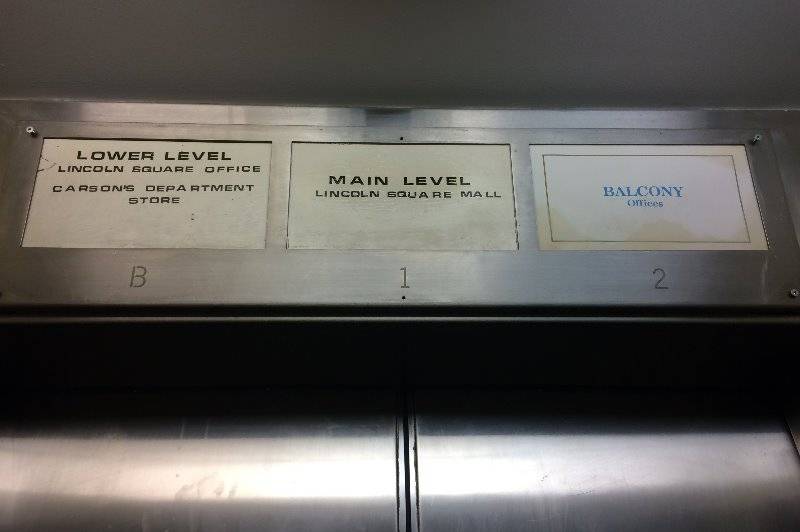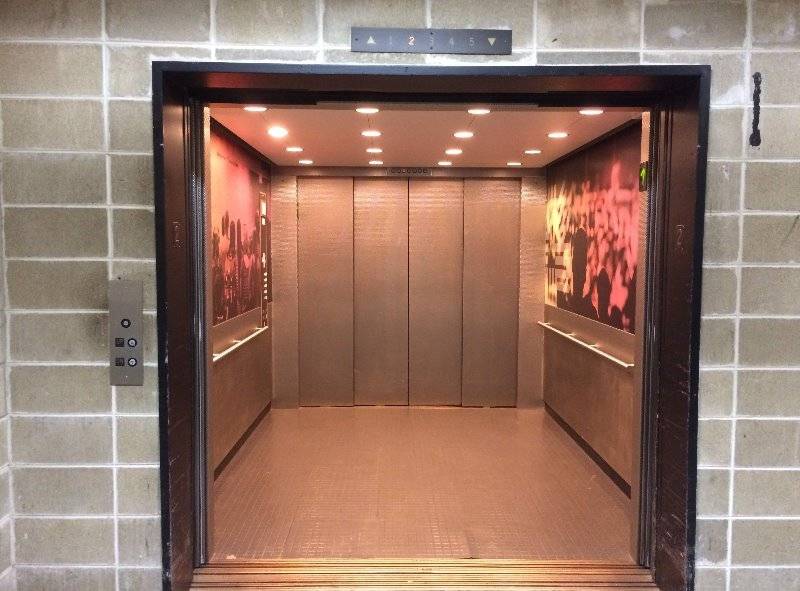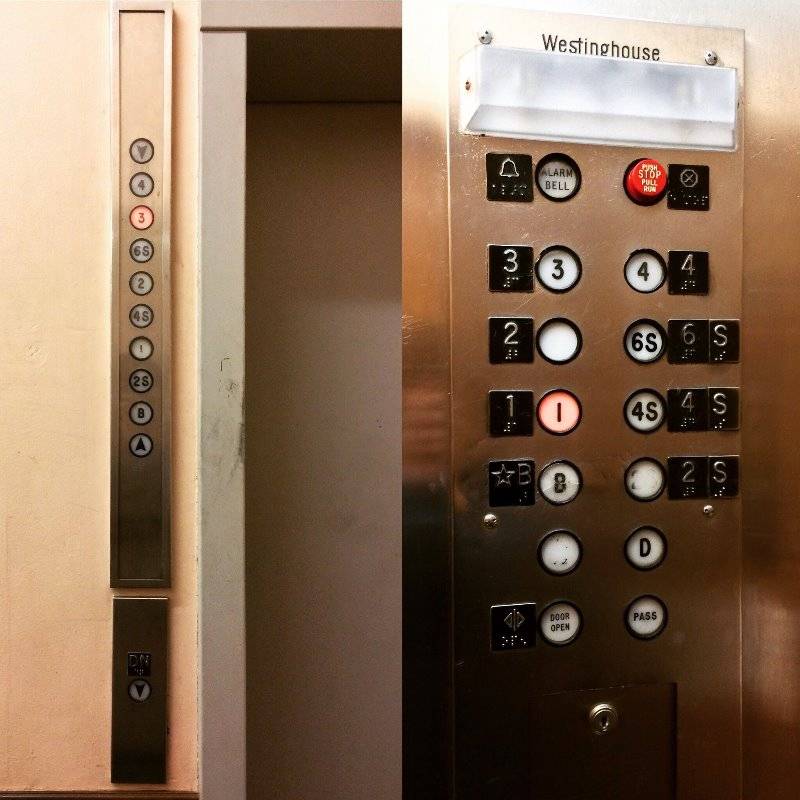Commonly overlooked as boxes that transport us from one floor to another or that plummet to the bottom in movies, there are actually people who like elevators. Let me repeat that, there are people who actually have a field day with elevators and I’m one of them. I like elevators so much that I go into buildings with a camera and document an up and down trip on an elevator.
Now before you get weirded out by this, let me explain. I was diagnosed with Asperger’s, which is part of the Autism spectrum. One of the perks of having Asperger’s is that people have unique fascinations to things such as tornado sirens, buses, trains, vacuum cleaners, and yes, elevators. I’m not necessarily sure why I have such an interest in elevators, but needless to say, my enthusiasm towards them is strong and enthusiastic.
 Original elevator floor directory at Lincoln Square Mall
Original elevator floor directory at Lincoln Square Mall
Since October of 2013, I’ve participated in a niche sub-culture called “elevator photography” where enthusiasts such as myself photograph and film elevators from the cities we live in or visit and we upload our experiences to YouTube. It was started by an individual named Andrew Reams who goes under the YouTube username, Dieselducy and currently has over a million views of videos that are mostly of him riding elevators. Like Andrew, I too film my rides on elevators, but I am just one of many enthusiasts. For Andrew, what initially became a hobby turned into something bigger. It became a cause for awareness to both Autism and unique interests. Little did he know that the hobby would also start a sub-culture of elevator enthusiasts.
 Windowed freight elevator shaft at Turner Greenhouse
Windowed freight elevator shaft at Turner Greenhouse
For me it all started my freshman year of college. While UIUC is a mecca of technology, most of their buildings remain relatively untouched since the 1960s, this includes most of the elevators. We elevator enthusiasts love the pre-ADA era elevators. I’ve seen so many videos of YouTubers getting excited over an old elevator that would probably be considered basic to the average person. With the university having all these 40 to 50-year-old elevators still in use, it was the perfect opportunity to become a YouTuber and show off what the campus had. The university is slowly but surely modernizing its campus, so in the next 5 or 10 years, most if not all of these old elevators will be modernized or replaced. This is why it is important to document with photography and video, not just for elevators, for everything. Being able to capture something that will forever be viewed is one of the best forms of storytelling and that is what I am doing, but with elevators.
Though all elevators do go up and down, not all of them are the same. In the movies you see elevators that are lifted with these cables and those are called traction elevators. What you often don’t see in the spotlight are hydraulic elevators which unlike traction elevators, do not have cables lifting the cab. Though in history the traction elevator came first, in the last 50 to 60 years, hydraulic elevators have been the go-to choice for a lot of low-rise buildings where there is no need to have express elevators. In place of the cables, hydraulic elevators ascend and descend by a hydraulic piston that is being pushed by hydraulic oil. When the elevator goes up, oil puts force on the piston. When going down, that force is released at a steady rate.
Traction elevators these days are seen in most high-rise buildings and tend to travel at faster speeds than a hydraulic elevator. They are the ones that are lifted by cables. And no, the elevator doesn’t just plummet to the ground even if the cables were to snap. If the elevator car were to free fall, a device called a governor would activate a breaking system that clamps to railroad like rails attached to the right and left side of the shaft. The chances of an elevator falling to the very bottom are very rare, but the filming industry likes to depict it as otherwise. Yes, it’s entertaining, but really it gives people a fear of elevators. To the people who are either studying or are active in the filming industry, STOP SHOWING ELEVATOR CRASHES. You’re more likely to injure yourself falling down stairs than from an elevator related accident. Old or new, elevators are safe.
In terms of knowledge, my understanding of elevators is basic to say the least and that’s how it is with most enthusiasts. I can tell the difference between traction and hydraulic elevators based on the sounds they make as well as the brand based on the buttons and the logo. The rest I learn from the mechanics I follow on Instagram, some have since become my friends and have been helpful with elevator-related questions. Being able to distinguish if an elevator is traction or hydraulic is actually fairly simple to identify, even individuals who are not enthusiasts can learn by sound association. Hydraulic elevators will make this humming sound going up while they make a hissing/draining noise when going down. For traction elevators, the sound is more or less the same in either direction. Of course, if they’re scenic you’ll be able to see the cables or piston, which most enthusiasts like to see too. When it comes to elevator enthusiasm, you don’t want to be a know-it-all because when it comes to elevator knowledge, it’s the technicians who are the real experts and I’m grateful to have become friends with them.
 Elevator at Krannert Center
Elevator at Krannert Center
Some of the most prominent elevators found in the Champaign-Urbana area include the Krannert Center for the Performing Arts, the Natural Resources building, Busey Bank in downtown Urbana, and the Main Stacks elevators in the University Library. Each of these elevators are prominent for having at least one or more unique feature. The Krannert Center elevator in particular is one of the largest on campus and is big enough to transfer a baby grand piano. The Natural Resources building is known for having a brass exterior on the first floor with a clock-like floor indicator (shown in top photo). The elevator in Busey Bank is known for being scenic and not completely enclosed.
 Elevator serving some decks at UIUC main library (Not inside the stacks)
Elevator serving some decks at UIUC main library (Not inside the stacks)
Finally, the elevators in the Main Stacks are known for serving decks rather than full floors, meaning that the structure is about the same height as the rest of the library, but instead of serving four floors, the ceiling to floor height is shortened. Each elevator serves a total of ten decks. All of these elevators with exception of the Main Stacks are publicly accessible. If you are a current student or employee at UIUC, I urge you to visit the stacks at least once before your ability to access them ends.
The fact that elevators are overlooked surprises me because without them, we wouldn’t have the iconic skyscrapers such as the Sears/Willis Tower in Chicago, the Empire State Building in New York, or the ADA act. It’s the one invention that is most important to have in a building right next to the lightbulb. I might sound biased but to me elevators are the unsung heroes in history. They help keep the artery of movement flowing in a building as easily as possible.
It doesn’t take much to become an elevator enthusiast, all you need is basic knowledge of the mechanics and the brands. If you’re still unsure, Google is your best friend. You can look up multiple videos on YouTube or even go to Wikipedia. The only must-do in becoming an elevator enthusiast is actually riding an elevator. If you’ve ridden an elevator then you meet all qualifications.
Elevator photography is part of who I am, and it’s brought a lot of joy in my life. I hope to one day travel around the world and film the many overlooked treasures called elevators. Until then, I’ll be documenting the many elevators in Champaign-Urbana.
Feel free to check out my YouTube Channel as well as my friend Dieselducy to experience some elevator photography.
Photos by Theodore Pfeffer








